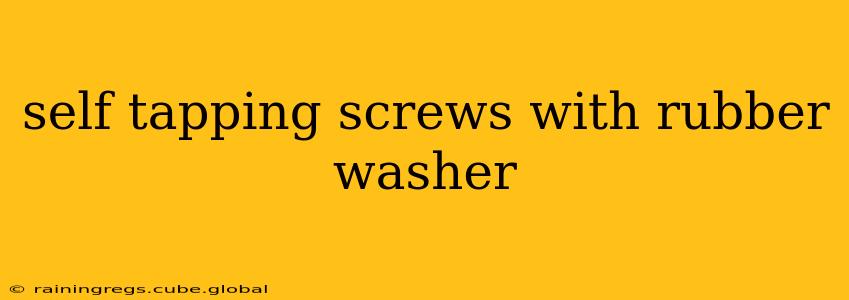Self-tapping screws are incredibly versatile fasteners, but adding a rubber washer elevates their functionality significantly. This combination offers superior sealing, vibration dampening, and even improved grip in certain applications. This guide delves into the specifics of self-tapping screws with rubber washers, exploring their benefits, applications, and considerations for successful installation.
What are Self-Tapping Screws?
Before diving into the specifics of rubber washers, let's clarify what self-tapping screws are. These screws create their own threads as they are driven into the material, eliminating the need for pre-drilling in many cases. This makes them incredibly convenient and time-saving for various projects. They come in a wide array of materials (like steel, stainless steel, and brass), sizes, and head types (Phillips, flat, pan, etc.), offering flexibility for diverse applications.
Why Use a Rubber Washer with Self-Tapping Screws?
The addition of a rubber washer to a self-tapping screw provides several key advantages:
-
Improved Sealing: Rubber washers create a watertight seal, preventing leaks and protecting the underlying material from moisture damage. This is crucial in outdoor applications or anywhere water resistance is paramount.
-
Vibration Dampening: The rubber's elasticity absorbs vibrations, preventing loosening and extending the lifespan of the screw. This is particularly beneficial in applications subject to significant vibrations, such as automotive or machinery installations.
-
Increased Grip and Stability: The rubber washer can provide additional grip on the surface, preventing slippage and ensuring a more secure fastening. This is especially helpful with smoother surfaces where the screw might otherwise have less purchase.
-
Protection Against Wear and Tear: The rubber washer acts as a buffer, absorbing some of the impact and friction during installation and use. This helps to prevent wear and tear on both the screw and the material it's fastened into.
What are the Different Types of Rubber Washers?
Rubber washers come in various shapes, sizes, and materials. The most common types include:
-
Standard Washers: These are simple, flat washers made from various types of rubber, offering a basic level of sealing and vibration dampening.
-
EPDM Washers: Ethylene Propylene Diene Monomer (EPDM) rubber is known for its excellent resistance to weathering, ozone, and chemicals. These washers are ideal for outdoor and harsh-environment applications.
-
Neoprene Washers: Polychloroprene (neoprene) rubber offers good resistance to oils, fuels, and many chemicals. These are often chosen for automotive and industrial applications.
-
Silicone Washers: Silicone rubber offers excellent heat resistance and is often used in high-temperature applications.
The choice of rubber washer will depend on the specific application and the environmental conditions.
What are the Applications of Self-Tapping Screws with Rubber Washers?
The combination of a self-tapping screw and a rubber washer finds application in numerous areas, including:
-
Automotive: Securing body panels, trim pieces, and other components, ensuring water tightness and vibration resistance.
-
Marine: Fastening deck fittings, railings, and other components, preventing leaks and corrosion.
-
Construction: Attaching roofing materials, siding, and other exterior components, protecting against moisture damage.
-
Electronics: Securing components and shielding against vibrations and interference.
-
HVAC: Fastening ductwork and other components, creating airtight seals.
How to Install Self-Tapping Screws with Rubber Washers?
Installation is generally straightforward. Place the rubber washer over the screw head before inserting it into the material. Ensure the washer is properly seated to maximize its sealing and dampening capabilities. Use an appropriate screwdriver bit to drive the screw in straight and snugly. Avoid over-tightening, which can damage the screw, washer, or material.
What Size Self-Tapping Screw Should I Use?
The appropriate screw size depends heavily on the material being fastened and the specific application. Consult manufacturer specifications for guidance.
Are Self-Tapping Screws with Rubber Washers Reusable?
Generally, these are not designed for reuse. The rubber washer might deform upon removal, compromising its sealing and dampening properties. It’s best practice to use new screws and washers for each installation.
What Material are Self-Tapping Screws with Rubber Washers Typically Made Of?
Self-tapping screws are often made of steel, stainless steel, or brass, while rubber washers are made from materials like EPDM, neoprene, silicone, or other rubber compounds depending on the required characteristics, such as chemical resistance or temperature tolerance.
This comprehensive guide should give you a firm understanding of self-tapping screws with rubber washers and their applications. Remember to always choose the right screw size, washer material, and installation technique for your specific project. Consulting manufacturer specifications is always recommended.
